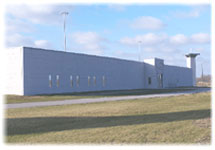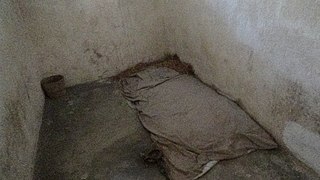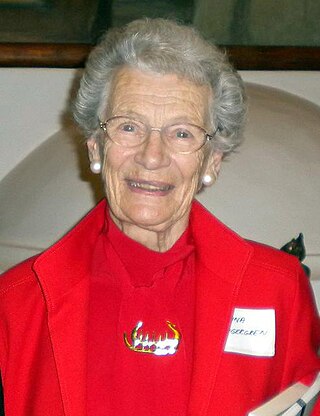Related Research Articles

Raoul Gustaf Wallenberg was a Swedish architect, businessman, diplomat, and humanitarian. He saved thousands of Jews in German-occupied Hungary during the Holocaust from German Nazis and Hungarian fascists during the later stages of World War II. While serving as Sweden's special envoy in Budapest between July and December 1944, Wallenberg issued protective passports and sheltered Jews in buildings which he declared as Swedish territory.

Solitary confinement is a form of imprisonment in which an inmate lives in a single cell with little or no contact with other people. It is a punitive tool used within the prison system to discipline or separate inmates who are considered to be security risks to other inmates or prison staff, as well as those who violate facility rules or are deemed disruptive. However, it is also used as protective custody on inmates whose safety is threatened by other inmates in order to separate them from the general prison population.

Pelican Bay State Prison (PBSP) is a supermax prison facility in Crescent City, California. The 275-acre (111 ha) prison takes its name from a shallow bay on the Pacific coast, about 2 mi (3.2 km) to the west.

The Shlisselburg Fortress or Oreshek Fortress is one of a series of fortifications built in Oreshek on Orekhovy Island in Lake Ladoga, near the present-day city of Saint Petersburg, Russia. The first fortress was built in 1323. It was the scene of many conflicts between Russia and Sweden and changed hands between the two empires. During World War II, it was heavily damaged. Today it is part of the UNESCO World Heritage site Historic Centre of Saint Petersburg and Related Groups of Monuments.

Per Johan Valentin Anger was a Swedish diplomat. Anger was Raoul Wallenberg's co-worker at the Swedish legation in Budapest during World War II when many Jews were saved because they were supplied with Swedish passports. After the war, he spent a lot of time trying to clarify Wallenberg's fate.

Anna Mikhailovna Larina was the third wife of the Bolshevik leader Nikolai Bukharin and spent many years trying to rehabilitate her husband after he was executed in 1938. She was the author of a memoir entitled This I Cannot Forget.

The Angola Three are three African-American former prison inmates who were held for decades in solitary confinement while imprisoned at Louisiana State Penitentiary. The latter two were indicted in April 1972 for the killing of a prison corrections officer; they were convicted in January 1974. Wallace and Woodfox served more than 40 years each in solitary, the "longest period of solitary confinement in American prison history".

The Federal Correctional Complex, Terre Haute is a United States federal prison complex for male inmates in Indiana; much of the complex grounds is in Terre Haute, though portions are in unincorporated Vigo County. It is operated by the Federal Bureau of Prisons, a division of the United States Department of Justice, and consists of two facilities:
Doing Time is a 2002 film directed by Korean-Japanese film director Yōichi Sai. Based on Kazuichi Hanawa's manga, it follows the day-to-day routine of a middle-aged inmate at a low security Japanese prison.
Upstate Correctional Facility is a maximum security state prison for men in Franklin County, New York, US. The prison, in the Town of Malone, was the first New York State prison built as a supermax.

Károly Szabó was an employee of the Swedish Embassy in Budapest from 1944 to 1945 when he rescued Hungarian Jews during the Holocaust. He was a supporter of Raoul Wallenberg and had a significant role in making contact with the representatives of the Hungarian police and other state officials. He was arrested without legal proceedings in 1953 in Budapest, in a secret trial.

Gustav Richter was an aide to Adolf Eichmann, an adviser on Jewish affairs (Judenberater), during Nazism era. He was a member of the Nazi Party and of the SS, the paramilitary organization of the Nazi Party.

Kresty prison, officially Investigative Isolator No. 1 of the Administration of the Federal Service for the Execution of Punishments for the city of Saint Petersburg, was a detention center in Saint Petersburg, Russia. The prison consists of two cross-shaped buildings and the Orthodox Church of St. Alexander Nevsky. The prison has 960 cells and was originally designed for 1,150 detainees.

Kronid Arkadyevich Lyubarsky was a Russian journalist, dissident, human rights activist and political prisoner.
Susan Mesinai is a poet, author and researcher/activist into the fates of foreign prisoners who disappeared into the Soviet Gulag during World War II and the Cold War. Co-founder of the Ark Project (1992–2005), she was founding president of the Independent Investigation into Raoul Wallenberg’s Fate, an educational human rights organization that furthers groundbreaking research carried out in the former Soviet Union, independently and under the aegis of an official Swedish-Russian working group.

In the United States penal system, upwards of 20 percent of state and federal prison inmates and 18 percent of local jail inmates are kept in solitary confinement or another form of restrictive housing at some point during their imprisonment. Solitary confinement (sometimes euphemistically called protective custody, punitive segregation (PSEG) or room restriction) generally comes in one of two forms: "disciplinary segregation," in which inmates are temporarily placed in solitary confinement as punishment for rule-breaking; and "administrative segregation," in which prisoners deemed to be a risk to the safety of other inmates, prison staff, or to themselves are placed in solitary confinement for extended periods of time, often months or years.

Vazif Sirazhutdinovich Meylanov was a Soviet mathematician, social philosopher, writer, Soviet dissident and political prisoner (1980–1989). He became renowned for his critical works on theory of socialism as well as for singular endurance and uncompromising attitude towards authorities during his prison terms. After imprisonment and exile Vazif Meylanov dealt with the problem of personal freedom, examined social and political environment, dispelled stereotypes about Russian democracy and analyzed political consciousness of Russian society. Besides, he was an opponent of nationalism and Islamism, while he proposed that the idea of rule of human rights should be a basis for human relationships and strong state machine should enforce rights.

The Raoul Wallenberg Centre for Human Rights (RWCHR) is a Canadian non-governmental organization dedicated to pursuing justice through the protection and promotion of human rights. The RWCHR's name and mission is inspired by Raoul Wallenberg's humanitarian legacy.

Nina Viveka Maria Lagergren was a Swedish businesswoman and the half-sister of Raoul Wallenberg, and the leading force to find out what happened to him after his disappearance. She was the founder of the Raoul Wallenberg Academy. She also presented Sommar i P1 in 2014 on Swedish Radio. She was the mother-in-law of Kofi Annan.
References
- ↑ Topping, Seymour (1961-09-05). "Soviet Jails U.S. Tourist as Spy; To Try Him as Western Agent". The New York Times. pp. 1, 8. Retrieved 2019-04-28.
- ↑ Knight, Amy (2001-09-20). "The Truth about Wallenberg". New York Review of Books. ISSN 0028-7504 . Retrieved 2019-04-28.
- ↑ Makinen, Marvin W.; Kaplan, Ari D. (2000-12-15). Cell Occupancy Analysis of Korpus 2 of the Vladimir Prison: An Examination of the Consistency of Eyewitness Sightings of Raoul Wallenberg with Prisoner Registration Cards from the Prison Kartoteka (PDF).